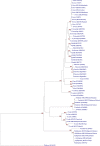First case of a naturally acquired human infection with Plasmodium cynomolgi
- PMID: 24564912
- PMCID: PMC3937822
- DOI: 10.1186/1475-2875-13-68
First case of a naturally acquired human infection with Plasmodium cynomolgi
Abstract
Since 1960, a total of seven species of monkey malaria have been reported as transmissible to man by mosquito bite: Plasmodium cynomolgi, Plasmodium brasilianum, Plasmodium eylesi, Plasmodium knowlesi, Plasmodium inui, Plasmodium schwetzi and Plasmodium simium. With the exception of P. knowlesi, none of the other species has been found to infect humans in nature. In this report, it is described the first known case of a naturally acquired P. cynomolgi malaria in humans.The patient was a 39-year-old woman from a malaria-free area with no previous history of malaria or travel to endemic areas. Initially, malaria was diagnosed and identified as Plasmodium malariae/P. knowlesi by microscopy in the Terengganu State Health Department. Thick and thin blood films stained with 10% Giemsa were performed for microscopy examination. Molecular species identification was performed at the Institute for Medical Research (IMR, Malaysia) and in the Malaria & Emerging Parasitic Diseases Laboratory (MAPELAB, Spain) using different nested PCR methods.Microscopic re-examination in the IMR showed characteristics of Plasmodium vivax and was confirmed by a nested PCR assay developed by Snounou et al. Instead, a different PCR assay plus sequencing performed at the MAPELAB confirmed that the patient was infected with P. cynomolgi and not with P. vivax.This is the first report of human P. cynomolgi infection acquired in a natural way, but there might be more undiagnosed or misdiagnosed cases, since P. cynomolgi is morphologically indistinguishable from P. vivax, and one of the most used PCR methods for malaria infection detection may identify a P. cynomolgi infection as P. vivax.Simian Plasmodium species may routinely infect humans in Southeast Asia. New diagnostic methods are necessary to distinguish between the human and monkey malaria species. Further epidemiological studies, incriminating also the mosquito vector(s), must be performed to know the relevance of cynomolgi malaria and its implication on human public health and in the control of human malaria.The zoonotic malaria cannot be ignored in view of increasing interactions between man and wild animals in the process of urbanization.
Figures


References
-
- Chin W, Contacos PG, Collins WE, Jeter MH, Alpert E. Experimental mosquito-transmission of Plasmodium knowlesi to man and monkey. Am J Trop Med Hyg. 1968;17:355–358. - PubMed
-
- Contacos PG, Elder HA, Coatney GR, Genther C. Man to man transfer of two strains of Plasmodium cynomolgi by mosquito bite. Am J Trop Med Hyg. 1962;11:186–193. - PubMed
-
- Chin W, Contacos PG, Coatney GR, Kimball HR. A naturally acquired quotidian-type malaria in man transferable to monkeys. Science. 1965;149:865. - PubMed
Publication types
MeSH terms
Substances
Associated data
- Actions
LinkOut - more resources
Full Text Sources
Other Literature Sources
Medical
Molecular Biology Databases

